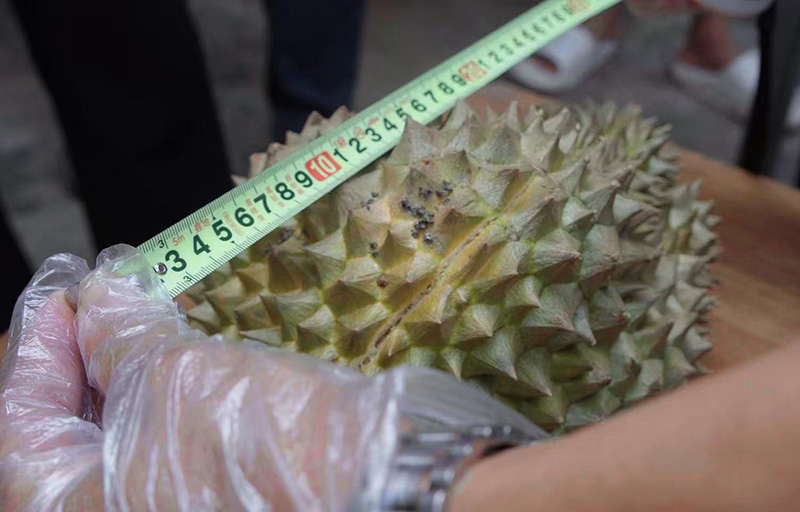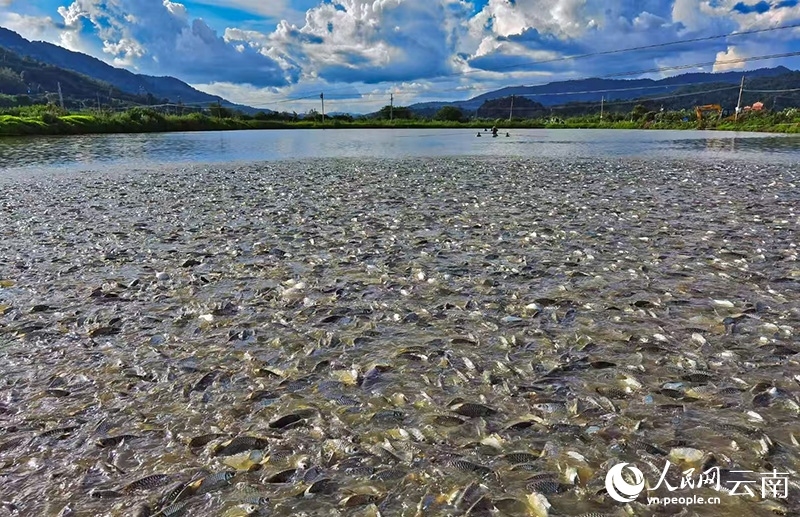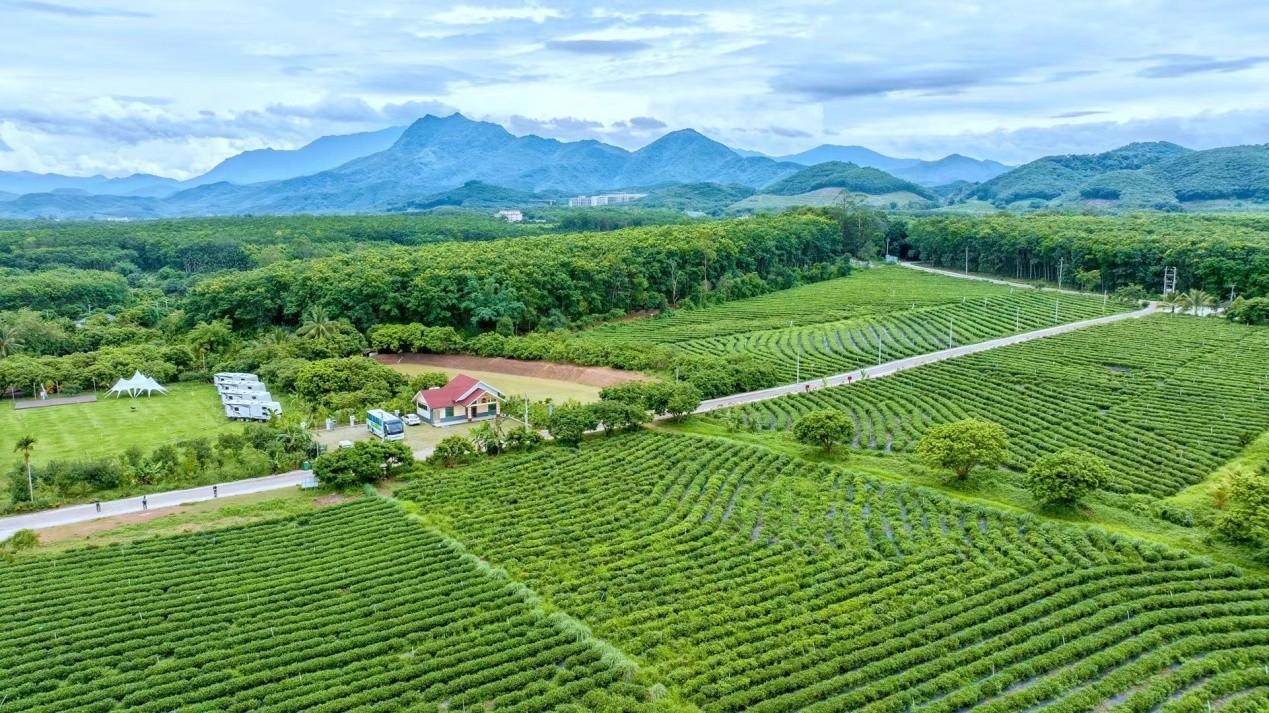Xishuangbanna in SW China's Yunnan builds distinctive modern agricultural system
Xishuangbanna Dai Autonomous Prefecture in southwest China's Yunnan Province serves as one of the country's important tropical zones. Rich in biodiversity and abundant with fruits year-round, it has built a distinctive modern agricultural system. Its three core pillar industries — tea, rubber and sugar — account for over 47 percent of the prefecture's industrial economy, providing solid support for local development.
Rubber tappers work hard at the plantation of Mengla Tianye Rubber Sales Co., Ltd. in Xishuangbanna.

Photo shows a homegrown durian in Mengla county, Xishuangbanna Dai Autonomous Prefecture, southwest China's Yunnan Province. (Photo courtesy of the publicity department of the Communist Party of China Xishuangbanna Dai Autonomous Prefecture committee)
"We've partnered with research institutes to develop superior tree varieties with high yields, strong disease resistance and high molecular weight. These trees can be tapped year-round," said Li Yun, deputy general manager of the company.
In 2024, Xishuangbanna's natural rubber cultivation area reached 4.658 million mu (about 310,533 hectares), accounting for 27.8 percent of the national total and 55 percent of Yunnan's. Dry rubber output hit 357,000 tonnes, accounting for 37.3 percent of the national total and 62.3 percent of the provincial total. Last year, its entire rubber industrial chain generated over 25 billion yuan ($3.52 billion) in output value.
Inside the company's workshop, rubber processing lines run efficiently, with machinery humming throughout the facility.
"As one of Xishuangbanna's earliest private enterprises to enter the rubber industry, innovation has always been the keyword defining our development," Li said. Through industry-academia-research cooperation, the company has collaborated with the Rubber Research Institute of the Chinese Academy of Tropical Agricultural Sciences to develop high-molecular, high-performance aviation tire rubber, which is now widely used in medical, industrial and other sectors.
The company has also established a natural rubber trading platform for warehousing and spot transactions.

Photo shows a rubber plantation in Xishuangbanna Dai Autonomous Prefecture, southwest China's Yunnan Province. (Photo/Hu Bingqing)
During the 14th Five-Year Plan period (2021-2025), Xishuangbanna introduced policies to support the rubber industry and allocated dedicated funds to help enterprises upgrade, enabling the sector to pursue high-end, green transformation through technology-driven innovation. The prefecture now has 134 rubber-related enterprises producing tire rubber, concentrated latex, latex products and more. Three companies have each surpassed 1 billion yuan in output value.
This September, a green, smart logistics park dedicated to natural rubber began operations. Covering 73.72 mu with a designed storage capacity of 50,000 tonnes, the facility serves upstream and downstream enterprises through efficient logistics coordination and smart warehousing technology.
"As of Nov. 3, the park had received 2,268 tonnes of goods and dispatched 298 tonnes," said Zhe Tianping, chairman of Xishuangbanna Natural Rubber Storage and Transportation Center Co., Ltd. Accelerating cargo turnover and intelligent warehousing is just the first step of the park, which aims to build a modern natural rubber supply chain hub integrating storage, processing, trade and finance.
Xishuangbanna has built a comprehensive rubber industry chain during the 14th Five-Year Plan period.
On Nov. 8, the 2025 Colorful Yunnan Granfondo Cycling Festival concluded in Xishuangbanna. The leg of the event in Jinghong city connected tropical rainforests, ancient tea mountains and ethnic villages, offering cyclists an exhilarating blend of speed and scenery.
Jinuoshan township in Jinghong city, famous for its Pu'er tea, lies along the route. It is home to more than 28,000 mu of ecological tea gardens, including over 4,000 mu of ancient tea gardens.

Farmers pick tea leaves in Jinuoshan township, Jinghong city, Xishuangbanna Dai Autonomous Prefecture, southwest China's Yunnan Province. (Photo courtesy of the Jinuoshan township government)
In recent years, the local government has strengthened protection of ancient tea mountains and developed premium tea plantations, while also exploring cultural tourism by launching tea-themed educational tours, intangible cultural heritage experiences and other programs. The result is an integrated tea-culture and tourism destination that combines sightseeing, leisure and hands-on activities.
"With winter's arrival, ancient tea garden hiking tours have become popular," said Rao Yaling, a staff member at the township government's agricultural and rural development service center. Since 2024, Jinuoshan township has welcomed over 970,000 hiker visits, helping village collectives earn 9.63 million yuan, creating over 3,000 jobs, and boosting the per capita income of those engaged in the sector by more than 50,000 yuan. Total tourism revenue has exceeded 350 million yuan.
Leveraging ancient tea mountain resources, Xishuangbanna has established pilot zones for the integrated development of its primary, secondary and tertiary industries. By 2024, the prefecture had completed 171 integrated development projects related to its ancient tea mountains.
From 2022 to 2024, Xishuangbanna topped Yunnan Province in freshwater fish fry production.

Photo shows an aquaculture facility of Xishuangbanna Yunbo Aquaculture Development Co., Ltd. in Xishuangbanna Dai Autonomous Prefecture, southwest China's Yunnan Province. (Photo/Wang Minqi)
During the 14th Five-Year Plan period, the prefecture has advanced seed industry revitalization and accelerated the construction of two breeding facilities: one for national winter breeding and one for improved freshwater fish breeds. It has also established 12 local standards for specialty industries, creating a comprehensive standard system across the industrial chain. Meanwhile, it has mobilized research institutes, universities and enterprises to develop key breeding technologies through joint research, with results first tested and applied locally.
Xishuangbanna has developed breeding facilities for improved aquatic species, including tilapia and the four major Chinese carp species. The prefecture has 46 aquatic breed facilities, with sales covering Yunnan Province and reaching Guangdong, Sichuan, Guizhou and beyond.
The prefecture has built a 6,000-tonne tilapia processing plant, the province's largest Australian red claw crayfish breeding facility, and a national-level aquaculture demonstration farm.
Photos
 Int'l delegation explores organic tea culture in Baisha, S China's Hainan
Int'l delegation explores organic tea culture in Baisha, S China's Hainan Chamber Concert of Chinese Classical Music held at China Cultural Center in Kuwait
Chamber Concert of Chinese Classical Music held at China Cultural Center in Kuwait 27th Harbin Ice-Snow World to officially begin construction in NE China
27th Harbin Ice-Snow World to officially begin construction in NE China Promotion week for intangible cultural heritage brands opens in Dali, China's Yunnan
Promotion week for intangible cultural heritage brands opens in Dali, China's Yunnan
Related Stories
- Tourists visit Xizhou old town in Dali City, China's Yunnan
- Yunnan emerges as China's outdoor sports hub
- Golden glow: ancient ginkgo tree stuns in autumn
- Zhoucheng Village, hometown of tie-dye technique of Bai ethnic group in China's Yunnan
- First batch of wintering black-headed gulls arrive at Lugu Lake in Yunnan
Copyright © 2025 People's Daily Online. All Rights Reserved.





